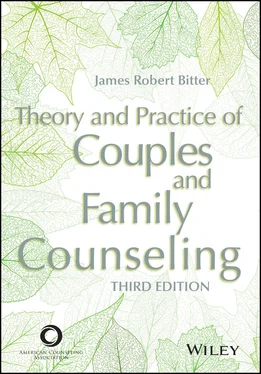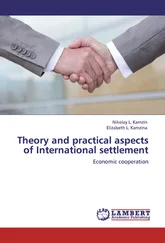James Robert Bitter - Theory and Practice of Couples and Family Counseling
Здесь есть возможность читать онлайн «James Robert Bitter - Theory and Practice of Couples and Family Counseling» — ознакомительный отрывок электронной книги совершенно бесплатно, а после прочтения отрывка купить полную версию. В некоторых случаях можно слушать аудио, скачать через торрент в формате fb2 и присутствует краткое содержание. Жанр: unrecognised, на английском языке. Описание произведения, (предисловие) а так же отзывы посетителей доступны на портале библиотеки ЛибКат.
- Название:Theory and Practice of Couples and Family Counseling
- Автор:
- Жанр:
- Год:неизвестен
- ISBN:нет данных
- Рейтинг книги:5 / 5. Голосов: 1
-
Избранное:Добавить в избранное
- Отзывы:
-
Ваша оценка:
- 100
- 1
- 2
- 3
- 4
- 5
Theory and Practice of Couples and Family Counseling: краткое содержание, описание и аннотация
Предлагаем к чтению аннотацию, описание, краткое содержание или предисловие (зависит от того, что написал сам автор книги «Theory and Practice of Couples and Family Counseling»). Если вы не нашли необходимую информацию о книге — напишите в комментариях, мы постараемся отыскать её.
Theory and Practice of Couples and Family Counseling — читать онлайн ознакомительный отрывок
Ниже представлен текст книги, разбитый по страницам. Система сохранения места последней прочитанной страницы, позволяет с удобством читать онлайн бесплатно книгу «Theory and Practice of Couples and Family Counseling», без необходимости каждый раз заново искать на чём Вы остановились. Поставьте закладку, и сможете в любой момент перейти на страницу, на которой закончили чтение.
Интервал:
Закладка:
Feminist Family Counseling
Key figures: Carol M. Anderson, Judith Myers Avis, Laura Brown, Betty Carter, Phyllis Chesler, Barbara Ehrenreich, Carolyn Enns, Carol Gilligan, Rachel T. Hare-Mustin, bell hooks, Deborah Anna Luepnitz, Dell Martin, Monica McGoldrick, Jean Baker Miller, Peggy Papp, Pam Remer, Patricia Robertson, Olga Silverstein, Lenore Walker, Froma Walsh, and Judith Worell, to name a very fewGrowing out of the feminist revolution of the 1960s and 1970s, feminist family therapists challenged patriarchy and the acceptance of White, male, heterosexual privilege inherent in the field of family therapy. They then went on to place gender role and power assessments, egalitarian relationships based on informed consent, consciousness-raising, assertiveness training, gender issues, and cultural diversity at the center of family counseling. Feminist family therapists understand patriarchy to be the dominant culture in all societies, and they have critiqued family systems theory for its lack of focus on gender and multicultural issues.
Evidence-Based Practice
Since the dawn of the 21st century, increased emphasis has been placed on interventions that show results. Cognitive behavioral counseling has led the way as an evidence-based practice, but solution-focused counseling from the postmodern tradition has also adopted this orientation, as have all three couples counseling models I present in this book.
Cognitive Behavioral Family Counseling
Key figures: Frank Dattilio, Albert Bandura, Aaron Beck, Albert Ellis, John Gottman, Neil Jacobson, Donald Meichenbaum, Gerald Patterson, Ivan Pavlov, B. F. Skinner, John Watson, Joseph WolpeAn application of behavioral learning theory and evidence-based practice to family counseling, cognitive behavioral family counseling blends the work of cognitive therapists, confronting irrational beliefs, with meth ods for shaping and reinforcing desired behaviors and interactions in families that research has shown to be effective. This model is preferred by most managed care facilities because it pragmatically addresses client actions and problems: It designs specific, often time-limited, interventions enacted in the service of ending identified dysfunctions or pathologies.
Parenting
Key figures: Alfred Adler, Diana Baumrind, Don Dinkmeyer, Rudolf Dreikurs, Haim Ginott, Thomas Gordon, John Gottman, James Lehman, Gary McKay, Cheryl McNeil, Jane Nelson, Michael PopkinA review of the major parent education programs and models currently used in the United States, this chapter presents models focused on democratic or authoritative-responsive parenting that use encouragement, active listening, reflective practice, natural and logical consequences, choices, and coaching in the service of building self-esteem in children and understanding and redirecting their mistaken goals. Emotion coaching and emotional intelligence are at the heart of raising competent, self-reliant kids and preparing them to cope with the challenges they will face throughout their development. This chapter is available at www. jamesrobertbitter.com.
Current Approaches to Couples Counseling
Three models of couples counseling currently dominate the field. They are the scientific approach of John and Julie Gottman, the emotionally focused therapy with couples developed by Susan M. Johnson, and imago therapy with couples as designed by Harville Hendrix and Helen Hunt. Each of these models is addressed in its own chapter. As you will have seen for the chapters above, there are also practitioners of couples counseling in the other models covered in the book. In addition, many prominent couples therapists, such as Pat Love (2001), Esther Perel (2009, 2017), and Froma Walsh (2016a, 2016b), work from their own unique perspectives.
The Science of Couples Counseling
Key figures: John Gottman, Julie Schwartz Gottman, Robert LevensonStarting in the 1970s, John Gottman and Robert Levenson began to study couples in conflict. Starting at the University of Illinois and later at the University of Washington, they conducted several longitudinal studies that eventually involved the psychophysiological measurement of couples in distress. They started with a study of sequential patterns in couples and found that couples’ interactions had enormous stability over time, that problems never really got resolved, and ultimately that there were patterns of interaction that predicted divorce just as there were patterns that characterized happy relationships. In the 1990s, John Gottman and his wife, Julie Schwartz Gottman, formed the Gottman Institute in Seattle, Washington. Their couples work is an example of translational research that involves the use of scientific data in the development of effective couples relationships.
Emotionally Focused Counseling With Couples
Key figures: Susan M. JohnsonSusan Johnson originally worked with Les Greenberg in the early development of emotionally focused therapy until Greenberg decided to go in a different direction, focusing primarily on individuals. Although both of these founders refer to their work as “emotionally focused,” they mean very different things by the term. Susan M. Johnson uses the term “emotionally focused therapy” to refer to relationships as a holding space for attachment issues and the possibility of a new emotional regulation. The end point of counseling is emotional connection, functional interdependence, safety and security, and a sense of belonging to each other.
Imago Counseling With Couples
Key figures: Harville Hendrix, Helen HuntSimilar to emotionally focused therapy with couples, imago therapy is built on an understanding of the breaches that occur in attachment and resulting childhood wounds. Hendrix notes that couples will often search through all possible partners who might be good for them to pick someone similar to people with whom they have unfinished business. In so doing, they look to the partner to stretch beyond the limitations of the original wounding relationship. To the extent that each partner can do this, the marriage or coupling becomes a path to wholeness. Imago therapy is built on identifying childhood wounds and then using highly structured dialogues to help the couple connect and fully engage with one another.
As you read these differing approaches to couples and family practice, know that it is impossible to integrate all of them. Some ideas and conceptualizations fit together better than others. It is enormously hard, for example, to see how social constructionist models and structural-strategic models might merge when the roles and functions of the family practitioners are so different. Similarly, it is hard to imagine how experiential models might be integrated with cognitive behavior therapy. But perhaps these last two statements only reflect my lack of imagination. Maybe you will see the thread that can be used to stitch such an integration into your own personal tapestry of family counseling.
Suggestions for Using the Book
I have attempted to write this book as if we were having a conversation. It still contains all the references you will need to further consider each topic, but its most important function is to invite you into the world of couples and family counseling and to consider whether this kind of work is right for you. Any kind of work in the helping professions, whether it is counseling, psychotherapy, or family practice, requires personal development as well as professional skills. There are many professions in which it is possible to be competent without addressing who we are as people—for example, engineering, visual arts, mathematics, or the sciences—although even these career fields are enhanced by personal develop ment and growth. In the helping professions, and especially in family practice, who you are as a person is central to everything you do: You are the instrument that provides the catalyst for change.
Читать дальшеИнтервал:
Закладка:
Похожие книги на «Theory and Practice of Couples and Family Counseling»
Представляем Вашему вниманию похожие книги на «Theory and Practice of Couples and Family Counseling» списком для выбора. Мы отобрали схожую по названию и смыслу литературу в надежде предоставить читателям больше вариантов отыскать новые, интересные, ещё непрочитанные произведения.
Обсуждение, отзывы о книге «Theory and Practice of Couples and Family Counseling» и просто собственные мнения читателей. Оставьте ваши комментарии, напишите, что Вы думаете о произведении, его смысле или главных героях. Укажите что конкретно понравилось, а что нет, и почему Вы так считаете.












